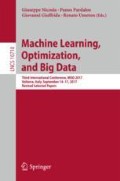Abstract
Water is not only vital for ecosystems, wildlife, and human consumption, but also for activities such as agriculture, agro-industry, and fishing, among others. However, in the same way as their water use has increased, it has also been detected an accelerated deterioration of its quality. In this sense, to have predictive knowledge about water quality conditions, can provide a significant relevance to many socio-economic sectors. In this paper, we present an approach to predict the water quality for different uses (aquaculture, irrigation, and human consumption) discovering knowledge from several datasets of American and Andean Watersheds. This proposal is based on Multiple Classifier Systems (MCS), including Bagging, Stacking, and Random Forest. Models as Naïve Bayes, KNN, C4.5, and Multilayer Perceptron are combined to increase the accuracy of the classification task. The experimental results obtained show that Random Forest and Stacking expose acceptable precision on different water-use datasets. However, Bagging with C4.5 was the most appropriate architecture for the problem addressed. These results indicate that MCS techniques can be used for improving accuracy and generalization capacity of the prediction tools used by stakeholder involvement in the water quality process.
Access this chapter
Tax calculation will be finalised at checkout
Purchases are for personal use only
References
Chapman, D.: Water Quality Assessments: A Guide to the Use of Biota, Sediments and Water in Environmental Monitoring. Taylor & Francis, Abingdon (1992)
Carbó, C.: Genética, patología, higiene y residuos animales (Genetics, Pathology, Hygiene and Animal Waste), vol. 4. Mundi-Prensa Libros (1995)
Dietterich, T.G.: Ensemble methods in machine learning. In: Kittler, J., Roli, F. (eds.) MCS 2000. LNCS, vol. 1857, pp. 1–15. Springer, Heidelberg (2000). https://doi.org/10.1007/3-540-45014-9_1
Grbović, J., Džeroski, S.: Knowledge discovery in a water quality database. In: Proceedings 1st International Conference on Knowledge Discovery and Data Mining (KDD 1995), Menlo Park, CA, pp. 81–86 (1995)
Bassiliades, N., Hatzikos, E., Koutitas, C., Antoniades, I., Vlahavas, I.: An intelligent system for monitoring and predicting water quality. In: Proceedings of the European Conference Towards eENVIRONMENT, Prague, Czech Republic, pp. 534–542 (2009)
Muhammad, S., Makhtar, M., Rozaimee, A., Aziz, A., Jamal, A.: Classification model for water quality using machine learning techniques. Int. J. Softw. Eng. Appl. 9(6), 45–52 (2015)
Partalas, I., Hatzikos, E., Tsoumakas, G., Vlahavas, I.: Ensemble selection for water quality prediction. In: Proceedings of the 10th International Conference on Engineering Applications of Neural Networks, Thessaloniki, p. 8 (2007)
U. S. Geological Survey, http://www.usgs.gov/. Accessed 14 April 2015
CVC - Segunda campaña de muestreo con propositos de calibracion del modelo de calidad del agua del rio cauca (Second sampling campaign with model calibration purposes of water quality in the Cauca river). Corporación Autónoma Regional del Valle del Cauca, Convenio Interadministrativo 0168, 27 noviembre 2002, vol. 15 (2005)
Borsdorf, A., Marchant, C., Mergili, M.: Agricultura Ecológica y Estrategias de Adaptación al Cambio Climático en la Cuenca del Río Piedras, pp. 7–73 (2013)
EPA - Watershed Characterization Report, https://ofmpub.epa.gov/waters10/watershed_characterization.control?pComID=3601974. Accessed 15 May 2017
Frawley, W., Piatetsky-Shapiro, G., Matheus, C.: Knowledge discovery in databases: an overview. AI Mag. 13(3), 57–70 (1992)
Zhou, Z.-H.: Ensemble Methods: Foundations and Algorithms. CRC Press, Boca Raton (2012)
Quinlan, J.: C4.5: Programs for Machine Learning. Morgan Kaufmann Publishers Inc., San Francisco (1993)
Wu, X.: Top 10 algorithms in data mining. Knowl. Inf. Syst. 14(1), 1–37 (2007)
Silverman, B., Jones, M.: An important contribution to nonparametric discriminant analysis and density estimation. Int. Stat. Rev. 57(3), 233 (1989)
Gurney, K.: An Introduction to Neural Networks. Taylor & Francis, Abington (2003)
Malsburg, C.: Frank Rosenblatt: Principles of Neurodynamics: Perceptrons and the Theory of Brain Mechanisms. In: Palm, D.G., Aertsen, D.A. (eds.) Brain Theory, pp. 245–248. Springer, Heidelberg (1986). https://doi.org/10.1007/978-3-642-70911-1_20
Russell, S., Norvig, P., Canny, J., Malik, J., Edwards, D.: Artificial Intelligence: A Modern Approach, vol. 2. Prentice Hall, Upper Saddle River (1994)
Breiman, L.: Stacked regressions. Mach. Learn. 24(1), 49–64 (1996)
Efron, B., Tibshirani, R.: An Introduction to the Bootstrap. CRC Press, New York (1994)
Wolpert, D.: Original contribution: stacked generalization. Neural Netw. 5(2), 241–259 (1992)
Vink, G., Frank, L., Pannekoek, J., van Buuren, S.: Predictive mean matching imputation of semicontinuous variables. Stat. Neerl. 68(1), 61–90 (2014)
Corrales, D.C., Corrales, J.C., Sanchiz, A., Ledezma, A.: Sequential classifiers for network intrusion detection based on data selection process. In: Proceedings of the 2016 IEEE International Conference on Systems, Man, and Cybernetics (SMC 2016), Budapest, Hungary, p. 1 (2016)
Kohonen, T.: Self-organized formation of topologically correct feature maps. Biol. Cybern. 43(1), 59–69 (1982)
Stehman, S.: Selecting and interpreting measures of thematic classification accuracy. Remote Sens. Environ. 62(1), 77–89 (1997)
Welch, B.L.: The generalization of “Student’s” problem when several different population variances are involved. Biometrika 34(2), 28–35 (1947)
The Little Handbook of Statistical Practice. http://www.jerrydallal.com/LHSP/LHSP.htm. Accessed 06 July 2017
Acknowledgements
The authors are grateful to the Telematics Engineering Group (GIT) and Environmental Studies Group (GEA) of the University of Cauca, Institute CINARA of the University of Valle, RICCLISA Program and AgroCloud project for supporting this research, and Colciencias (Colombia) for PhD scholarship granted to MsC. Iván Darío López.
Author information
Authors and Affiliations
Corresponding author
Editor information
Editors and Affiliations
Rights and permissions
Copyright information
© 2018 Springer International Publishing AG
About this paper
Cite this paper
López, I.D., Valencia, C.H., Corrales, J.C. (2018). A Data Mining Tool for Water Uses Classification Based on Multiple Classifier Systems. In: Nicosia, G., Pardalos, P., Giuffrida, G., Umeton, R. (eds) Machine Learning, Optimization, and Big Data. MOD 2017. Lecture Notes in Computer Science(), vol 10710. Springer, Cham. https://doi.org/10.1007/978-3-319-72926-8_30
Download citation
DOI: https://doi.org/10.1007/978-3-319-72926-8_30
Published:
Publisher Name: Springer, Cham
Print ISBN: 978-3-319-72925-1
Online ISBN: 978-3-319-72926-8
eBook Packages: Computer ScienceComputer Science (R0)

